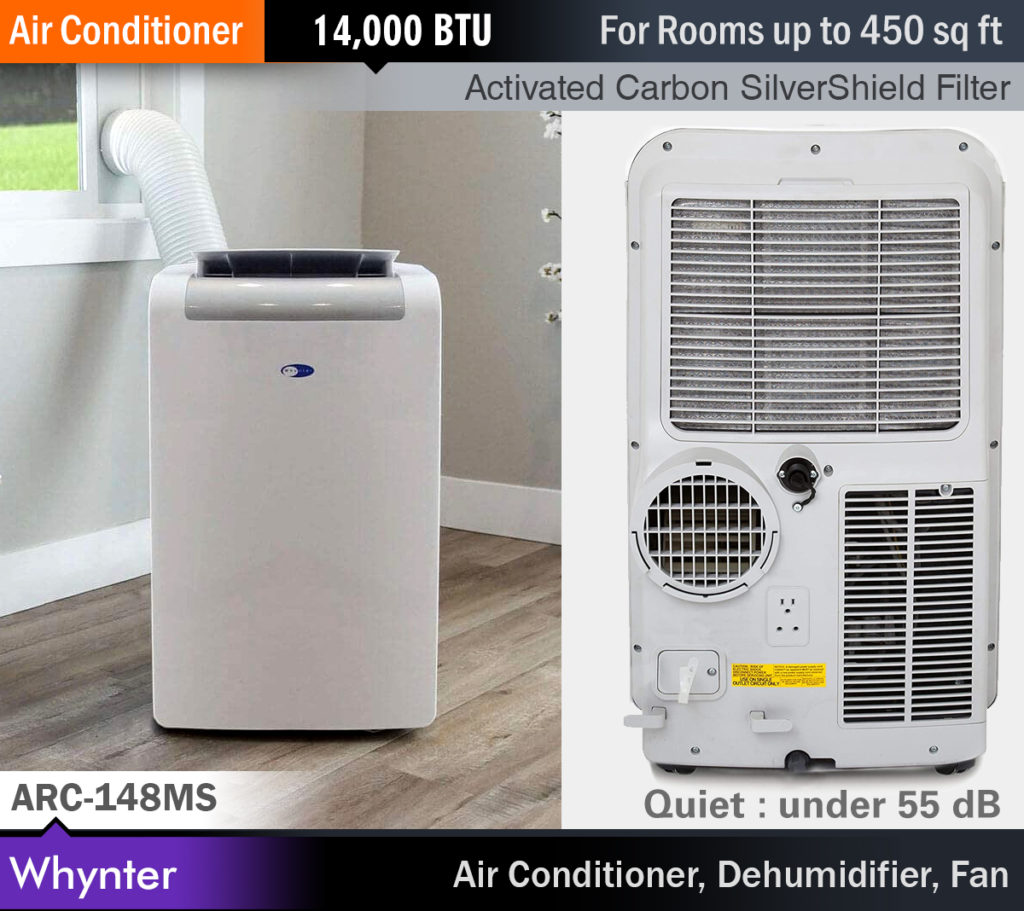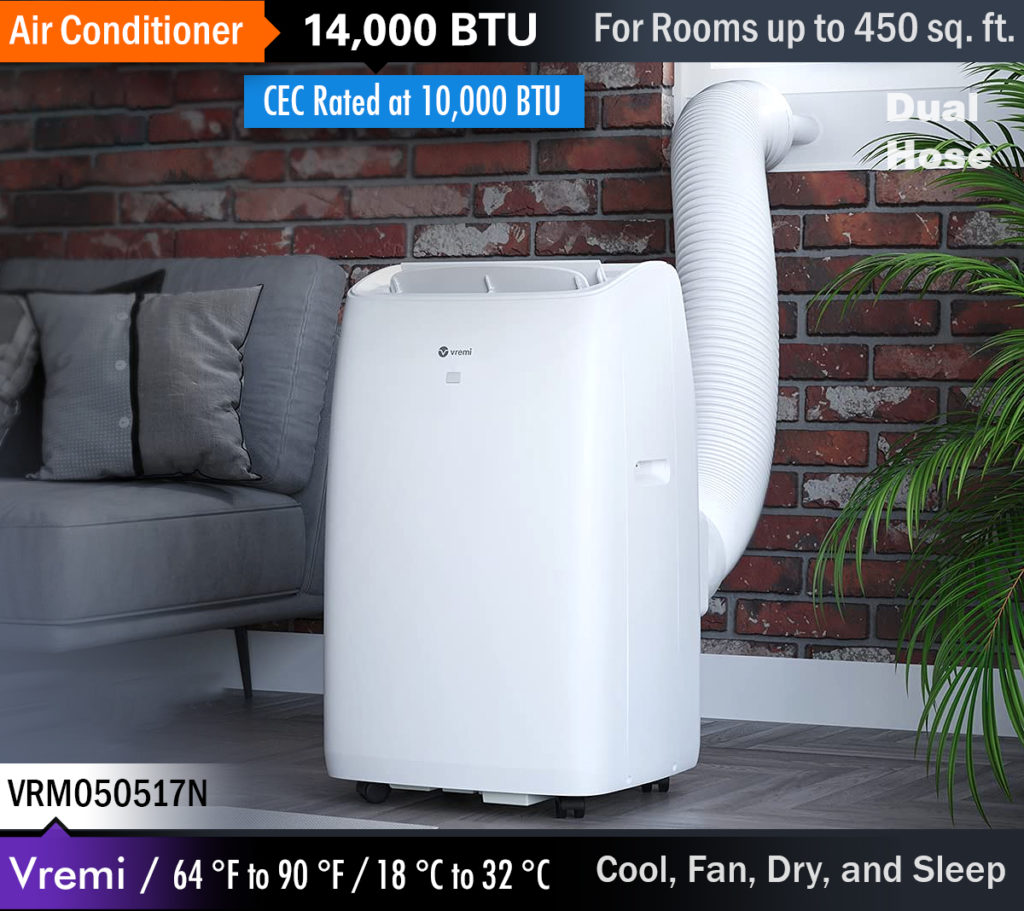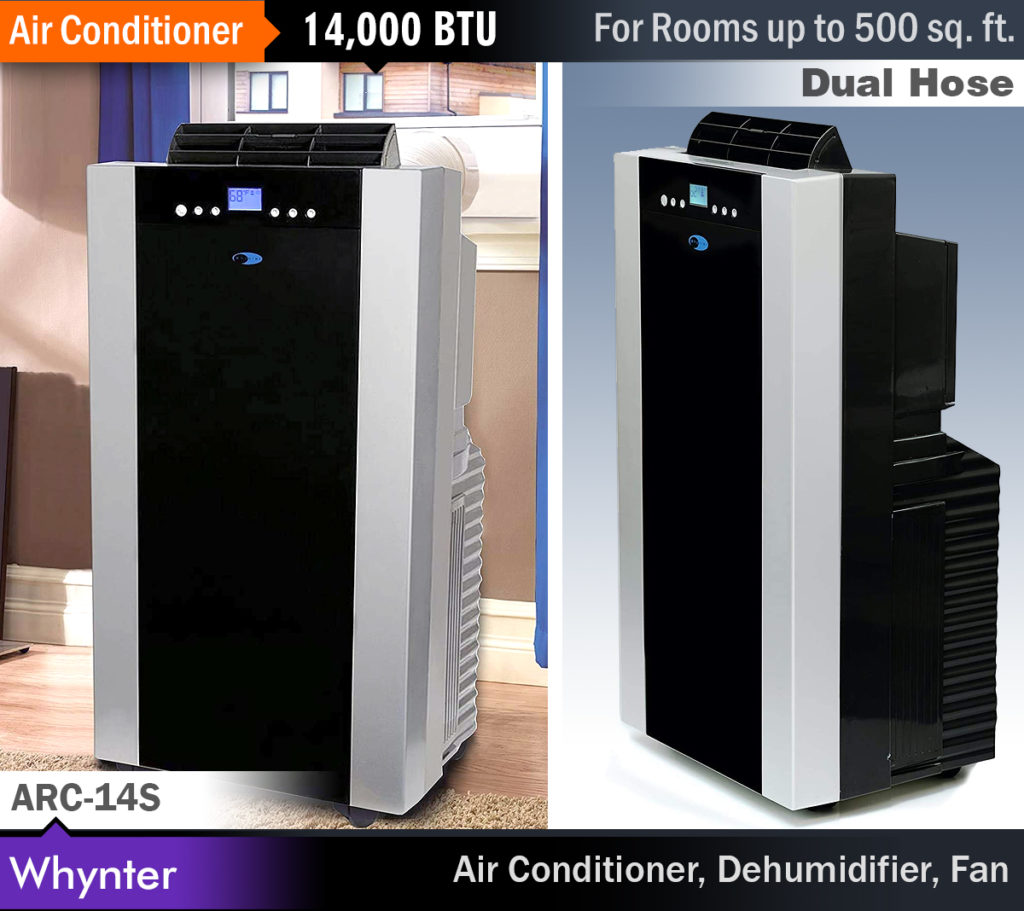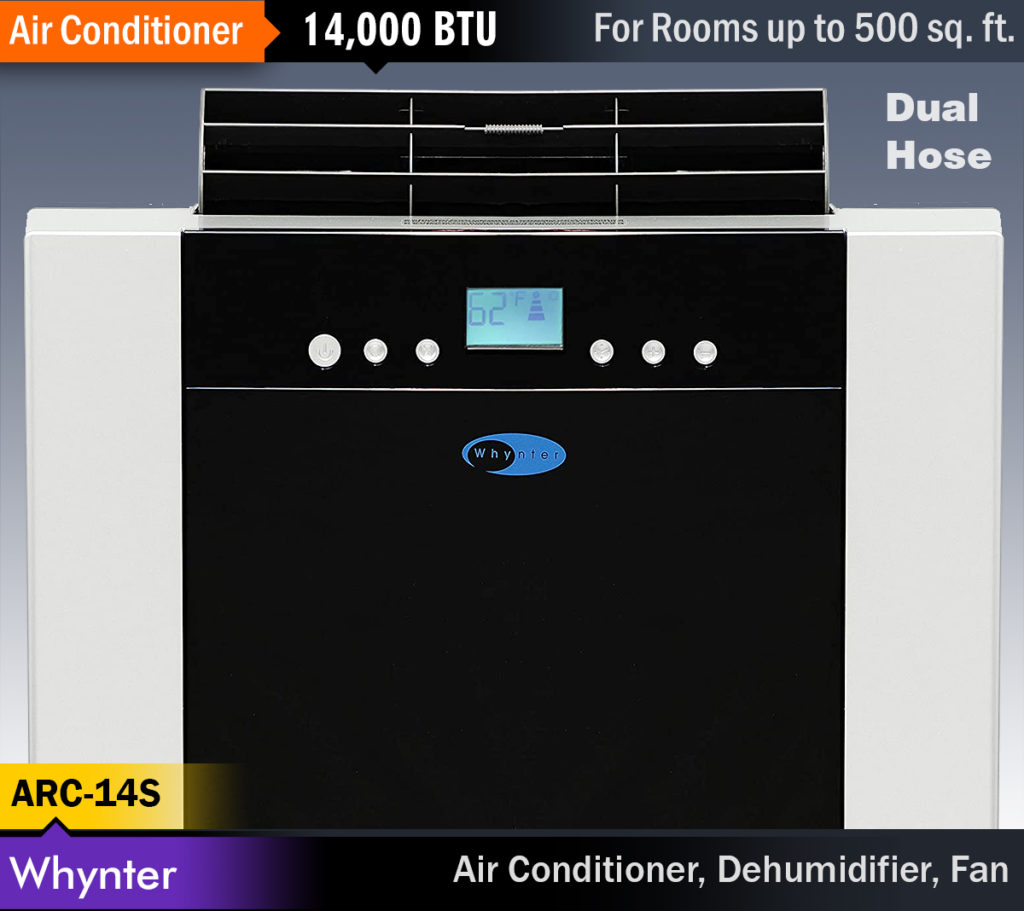
In this article we’re going to look at some of the best 14,000 BTU portable air conditioners for the money. If you’ve been listening to the news you’ve probably heard that 2021 is on target to be one of the hottest years on record. It’s June as I write this and I’m a little terrified about what’s to come.
Summer’s here and you know what that means: it’s going to be hot. In some areas of the world, most notably the United States, recent heat waves already have people seeking relief. With projections of more intense heat waves in the near future, having a reliable means of keeping cool can be a lifesaver. For many, though, investing in a central air conditioning system can be a costly if not impractical means of keeping cool. Fortunately, if you want to upgrade from running a fan, sitting in the shade or dousing yourself with ice water, portable air condition units can help you achieve the comfort you need when you’re trying to escape the heat. Below, we’ll go through some of the different reasons a portable air conditioner is a worthwhile investment and which models will help you beat the heat without feeling beaten.
Benefits of Air Conditioning
The first question you might have is, why do I need an air conditioner at all? There are many parts of the United States, such as the Pacific Northwest, where consistently cooler climates, and buildings unsuited for central air conditioning, disincentivize using air conditioning units. On the other hand, there are other parts of the country, such as the Southwest, Midwest and the Southeast, where consistent 100 degree plus days coupled with humidity can create oppressive heat conditions. In such places, having a reliable air conditioning supply may be an essential element to surviving in such climates.
Affordable 14K BTU Air Conditioner / Vremi VRM050517N

Whether you live in a harsh climate or not, air conditioning can be an important arsenal in creating a healthy indoor environment. Air conditioning does not just lower the air temperature but also helps to remove humidity and air particulates, given proper filtration systems. This is an important element in controlling various unwanted indoor contaminants, such as allergens and potential asthma triggers such as dust mites, mold and dander; given the recent and persistent concerns with airborne contaminants, air conditioning can help to control the spread of infectious agents.
Likewise, an air conditioning space helps to make the space more livable during oppressive heat as you are able to sleep better and not experience heat-associated discomforts such as headaches and coughs associated with poor indoor air quality. Most importantly, a properly air-conditioned space reduces if not eliminates the possibility of suffering from heat-related dehydration and heat stroke. This is of critical importance for the young, elderly or ill who may not have the capacity to properly cool themselves through sweating. When you amplify the health benefits by preventing exposure to noxious insects, such as mosquitoes and flies that prefer warm and humid environments, air conditioning can be a lifesaver for some.
Although not quite as important as maintaining your health, air conditioning is an important element when it comes to ensuring proper technological functionality. Excessive heat can cause computers to decrease their functionality, potentially causing systems to idle or shut down in order to prevent overheating circuitry. Similarly, excess humidity can disrupt circuitry and potentially lead to malfunctions.
Ideal temperatures should not exceed 82° for personal computers and 95° for laptops, though room temperature, around 70° Fahrenheit (20° Celsius), is the optimal temperature. Whether you work in a large office or have a home office, regular computer usage is vastly improved, if not sustained, by maintaining a proper indoor temperature. As an added bonus, sufficient cooling and humidity reduction associated with air conditioned spaces decrease the energy you need to expend to keep cool, preventing the lethargy that often accompanies hot weather. When it comes to improved work performance, A/C is key.
Ultimately, whether you are trying to stay comfortable, maintain productivity during warm weather or prevent heat-related illness, a properly air-conditioned space can eliminate the problems associated with sweltering summer weather.
Portable AC vs Central Air Conditioning
Perhaps one of the greater ironies in relation to air conditioning is that the process itself generates heat and distributes heat outside of your home, contributing to climate warming. As an added concern, an improperly operated air conditioning system or an inefficient system can not only waste money but prevent you from experiencing the benefits of air conditioning. That’s why, if you’re going to invest in an air conditioning system, it’s wise to make a sound investment in a system that is going to provide efficient cooling relative to the cost and performance of the system.
If you don’t already have central air conditioning or use the often commonplace window mounted air conditioning units, the question is, which is better, portable or central air conditioning? If you own your own home and plan on living there for the long-term, the initial up-front investment in a central air-conditioning system, which varies between markets and the structure of your home but which averages at least $5500, will help you to achieve a consistent temperature throughout your home for less than running multiple window-air conditioning units, the popular alternative to central air.
Further, central air conditioning is much less noisy than these window units and, if paired with a smart thermostat or other temperature control mechanism, can be configured to optimize cooling efforts so that most of the cooling is done when you are actually in your home. On the other hand, if you are only concerned with keeping one or two rooms cool, such as bedrooms at night, or to provide temporary or seasonal climate control, then window air-conditioning units can be much more effective and cost much less, particularly given the substantial installation costs, and expected maintenance costs, necessary for a central air conditioning system.
Window air conditioning units are not the only alternative to central air conditioning. Portable air conditioning units provide the same benefits of window air conditioning units, as far as creating customized air conditioning relative to the spaces you frequently use, while also offering the portability to move between different rooms, easy installation and the elimination of window units that many find obtrusive. Similarly, portable units can also be vented through a ceiling or wall, which increases the applicability; window units are typically mounted in windows, though some can be customized to fit through walls, and are generally left in place as they can be somewhat cumbersome.
While portable air conditioning units can be somewhat obtrusive regarding occupying floor space, many find that to be a worthwhile trade-off relative to their convenience and effectiveness. The next question is, how much air conditioning do you need?
What Size Air Conditioner Do You Need?
Having a properly sized portable air conditioning unit is an important consideration to ensure that your unit functions properly and you experience maximal efficiency during operation. If your unit is too small, then it will take longer to achieve the temperature you seek and may even prevent the space from reaching an optimal temperature. Using a unit that is too large can cause the unit to constantly cycle through the cooling mode when the room eventually cools down, which can decrease efficiency and possibly lead the unit to overheat.
A recommended gauge for determining how large of a unit to use is to find a unit that offers 20 BTU per square foot of space. Thus, a 500 square foot space would require a machine that produces 10,000 BTU of cooling, though the range of 10,000-14,000 of BTU is recommended given variations inherent to every indoor environment.
Other considerations that influence what size unit you should use are the height of the ceiling of the space that you are cooling, how shaded the space is, how many people occupy the space and what appliances are in the space. Higher ceilings (above 8 feet), more sun exposure, multiple people and the presence of appliances will all increase the BTU demand for the space, with a larger machine recommended; with more shading, lower ceilings, fewer people and smaller or no appliances, you need less demand.
Although portable air conditioning units are often used for rooms or stand-alone spaces, a portable air conditioning unit, especially one up to 14,000 BTUs, can effectively cool an apartment within the 500 square foot range. 14,000 BTU units are the greatest capacity for residential outlets, with more powerful commercial or industrial units requiring special outlets; for larger spaces or greater cooling, particularly for apartment dwellers who can’t or don’t want to make an investment in a central air conditioning unit, multiple portable air conditioning units can be used. Although size optimization is dependent on individual circumstances and cooling demands, 14,000 BTU units are generally the preferred option given that they provide a greater range of cooling that fits most consumer’s needs. The question, which 14,000 portable air conditioning unit is best? Let’s delve into the nuances of some popular models to help you find the portable air conditioning unit that will keep you cool when you need it most.
Reviews : Best 14,000 BTU portable air conditioners :
Before we delve into some of the leading models in 14,000 BTU portable air conditioners, there is one major distinction that is important in helping you choose the right model: single hose vs. double hose units. Single hose units are best for smaller rooms and operate by using a single filtration system that brings air from the room that you are cooling through the unit and expels it through the exhaust system. Problems can arise, however, if the room is too large, in which case these less efficient models can potentially overheat, and because the air filtration and exhausting process creates a negative pressure that can bring air in through unsealed openings in your home, potentially increasing the cooling load. The advantage of single hose portable air conditioners is that they are less expensive.
Double hose air conditioners work slightly differently as they draw in outside air, cool the air and then expel it into the space being cooled while simultaneously removing hot air from the space. While double hose portable air conditioners are more efficient and can heat larger spaces, they are slightly more expensive, are slightly more complicated to install and some units are slightly louder than single hose units. These considerations, along with whether units come with timers, are remote controlled, offer dehumidifiers within the unit and can be synced with smart phones are all considerations that influence which unit is right for you.
Review : Whynter ARC-14S / Best 14K BTU AC

► Can cool a room up to 500 sq.ft.
Features / Tech Specs :
| 14,000 BTU Cooling (ASHRAE-128 Standard) / 9,200 BTU (DOE 2017 Standard) | ECO-FRIENDLY CFC free GREEN R-32 refrigerant | |
| Dual hose operation | auto drain function | |
| Lead free RoHS compliant components | 3-IN-1 : Air conditioner, fan and dehumidifier | |
| Digital and remote control | LCDI (Leakage-Current Detection and Interruption) plug | |
| Dehumidifying Capacity: 71 Pts / day | 3 fan speeds | |
| Activated carbon air filter and washable pre-filter | Full thermostatic control (61°F – 89°F) | |
| Casters for easy mobility | 24 hour programmable timer | |
| Noise level : under 56dB | Auto restart after power outage | |
| Storage cover bag with pocket | Upgraded Plastic window kit included | |
| Window Kit : 6.5″ W x 20″ L (min.), 46″ (max.) | Exhaust/ Intake Hose: 5.9″ dia. | |
| Hose Connectors: 5.9″ dia. with 5.0″ diameter reducer | Refrigerant: R-32/16.5oz(468g) | |
| Air Flow (at high speed): 430 m3/h / 253 CFM | Max power usage: 1300 W / 11.6 A | |
| Weight: 73 lbs | UPC : 891207001545 |
OVERVIEW —
If you’re looking for a reliable and high-performance portable air conditioning unit, the Whynter ARC 14-S is the model for you. This dual hose model operates effectively in cooling rooms up to 500 square feet and does so without using chlorofluorocarbons, another environmental concern associated with air conditioning usage. Amplifying its efficiency is its auto drain technology which captures moisture from the cooling process and uses it to amplify its cooling process.
With the dual hose system, this model is extremely effective in rapidly cooling a room, and is so effective that it was rated better than any other portable units tested by Good Housekeeping in 2018. Measuring 16 x 19 x 36 inches, this unit is relatively compact and, weighing 80 pounds and with bottom-mounted casters, is easy to maneuver throughout the interior of your dwelling.
Although this unit is designed to operate as an air conditioner, it includes 2 other features that allow you to use it solely as a fan, with 3 speeds for optimal control, or dehumidifier, capable of removing 71 pts of air moisture per day, increasing its functionality while also tailoring its usage to your climate-control needs. This unit has a 24 hour programmable timer for optimal cooling coordination, an automatic restart function in the event of power outage and has a temperature range between 61 and 89 degrees Fahrenheit for customized cooling control.

With an air flow at high speed measuring 430 meters cubed/ hour, it falls well within the optimal range of 350-450 meter cubed/ hour recommended for residential air conditioning systems.
Using the ARC-14S is fairly simple. It comes equipped with a hose with maximum length of 60” and a window kit with dimensions of 6” x 20-46”, allowing a range of installation configurations. This unit comes with an activated carbon air filter and washable pre-filter, allowing you to ensure that your indoor air is of the highest quality; activated carbon filters allow units to remove particulates as well as odors, gases and even volatile organic carbon compounds, ensuring that your indoor space is cool and healthy. It operates on a general circuit rating of 115 V with a maximum power usage of 1300W, so it doesn’t warrant any special wiring. It’s noise output while operating is 56 decibels, at the lower end of the spectrum for air conditioning units.
An added feature is the protective cover with storage pocket included with each unit that prevents dust and other debris from collecting on the unit while it is stored during non-cooling seasons. The ARC-14S is a worthwhile investment for those looking to keep their spaces cool and efficient at the same time.
Review : Whynter ARC-148MS
While the two Whynter 14,000 BTU portable air conditioners may seem like two versions of the same concept, the ARC-148MS has some slight nuances that create a different functionality depending on your indoor climate control needs. As far as basic functionality, the two units are virtually identical. The ARC-148 MS operates up to 14,000 BTUs, with this model’s SACC (seasonally adjusted cooling capacity) being slightly higher than the ARC-14S at 10,300 BTU versus 9300 BTU. This difference in SACC allows the ARC-148 MS to provide slightly greater efficiency in cooling capacity relative to the same space.
The ARC-148 MS also has a 71 pint/day dehumidifying capacity, includes a 3 speed fan and a 24 hour programmable timer, and provides a temperature range of 62-88 degrees fahrenheit. The noise output is at a similar 55 decibels, the system operates on a 115 V circuit and the dimensions are fairly similar, with the ARC-148 MS measuring 18.5 x 15.75 x 30.25” and weighing 75 pounds. This unit will also fit into windows up to 48 inches in width, similar to the ARC-14S
Some of the differences in this Whynter model relate to overall performance, appearance and accessories. This system operates with a single hose which, although it performs within the same performance range as the ARC-14S, could potentially lead to overheating. The maximum air speed of the ARC-148 MS is 497 meters cubed/ hour, a bit higher than that of the ARC-14S. This unit also utilizes a washable silver-shield pre-filter with its activated carbon filter. Silver-imbedded filters have been shown to have antibacterial and antimicrobial properties, which may be an added incentive for those who are trying to ensure maximum hygiene within their indoor space.
An added feature of this model is that, in addition to having A/C, fan and dehumidifying modes, it contains an auto mode that can be set to automatically cool based on the environmental conditions. Other differences are that this unit does use cfc (chlorofluorocarbon) refrigerants and does not come with a protective cover for storing the unit when not in use. For those who are concerned with aesthetics, the ARC-148 MS comes in only white whereas the ARC-14S comes in platinum and black. These attributes are merely alternatives in operability rather than reductions in functionality, which is why the ARC-148 MS is priced at roughly the same price as the ARC-14S.
Review : Honeywell HJ4CESWK9
Best 14,000 BTU Portable Air Conditioner
The Honeywell HJ4CESWK9 is a powerful unit that provides the features highly sought from a portable air conditioning unit. Like the Whynter models listed above, this unit also offers 3-in-1 performance with air conditioning, a multi-speed fan and a dehumidifier. The dehumidifier function is extremely powerful and is capable of removing up to 90 pints of moisture per 24 hours. Although listed as a 14,000 BTU unit with an SACC rating of 9300 BTU, it is listed as being capable of cooling spaces of up to 700 square feet, demonstrating optimum performance relative to its climate control capabilities. With an operating volume of 52-55 decibels, this model is considered one of the quietest portable air conditioning units.
This Honeywell model also contains features similar to the Whynter units. It also uses an environmentally friendly refrigerant as well as an auto-evaporation system that reuses collected water to increase cooling performance. It is similarly sized for mobility, with casters on the bottom, a weight of 75 pounds and a measurement of 19 x 15 x 31 inches. It’s fan contains 3 fan speeds and also comes with washable filters as well as a dual dust filtration system to prevent the accumulation of dust and hair in the filtration system while extending its lifespan. With a continuous drain system that can be mounted with the window mounting feature, this model provides exceptional and consistent performance.
The only major detraction’s this model presents are a lower air filtration rate of 235 cubic feet/ minute and a slightly decreased window kit width of 38.2 inches. Despite these differences, its LCD, remote control display and programmable timer for scheduled operation provide preferred performance to optimize efficiency. Given these features, it’s quite affordable and well-made.
Review : HomeLabs HME020519N
Best 14,000 BTU Portable Air Conditioner
If you’re looking for an efficient portable air conditioner that is also economical and low-noise, the HomeLabs HME020519N is a solid option. At 14,000 BTUs, it performs similarly, though ratings suggest optimal square footage of cooled spaces of between 350-450 square feet. It is similarly sized to other models with dimensions of 20.3 x 18.2 and 34.7 inches and a weight of 75 pounds. Its CEER rating (combined energy efficiency ratio) is 8.1, making it well below the 11.0 rating necessary for air conditioners and indicating its high performance optimization. Like other portable air conditioners, it creates temperature ranges from 61-90 degrees Fahrenheit.
Like the other units listed, it comes with 3 modes: fan, air conditioning and dehumidifier. It is also remote control operated and uses an LED display to indicate its setting while displaying performance status. One of the advantages of this model is that it is exceptionally quiet, measuring 52 decibels while cooling so that you can sleep in peace in your climate-controlled space. It also contains a sleep function which automatically controls the temperature while you are asleep as well as remote control operation that allows you to set the temperature, time and mode.
Perhaps owing to its slightly decreased room-cooling capacity and its single hose design, this model is slightly less expensive than other models. The HME020519N costs on average $500.
Which is the best 14,000 BTU portable air conditioner?
Determining which of these units is the best 14,000 BTU portable air conditioner depends on which aspects you consider the most important. If cost and quiet operation are your main concerns, the HomeLabs HME020519N offers an effective model for its price that won’t keep you up at night. If high performance is your goal, the Honeywell HJ4CESWK9 offers exceptional cooling range for a slightly greater expense. Both Whynter models offer high performance cooling, with the ARC-148 MS offering slightly greater performance with respect to indoor air contaminant removal, while the ARC-14 S offers greater performance with respect to environmental efficiency.
All models have similar features with respect to functional modes, size and mobility, window size accommodation and remote operability, so your choice ultimately revolves around the distinction of each model with respect to price, cooling capacity, contaminant removal and environmental compatibility.
Whichever option you choose, these portable air conditioning units will provide consistent air conditioning while also providing the option to control fan-based air circulation as well as indoor moisture levels. It’s this kind of control relative to the expense of these units that makes these portable air conditioning units great options if you’re looking for economic and effective cooling devices. Before the summer heats up and you start sweating away your concerns, consider one of these best 14,000 BTU portable air conditioners so you can keep your cool all summer long.
